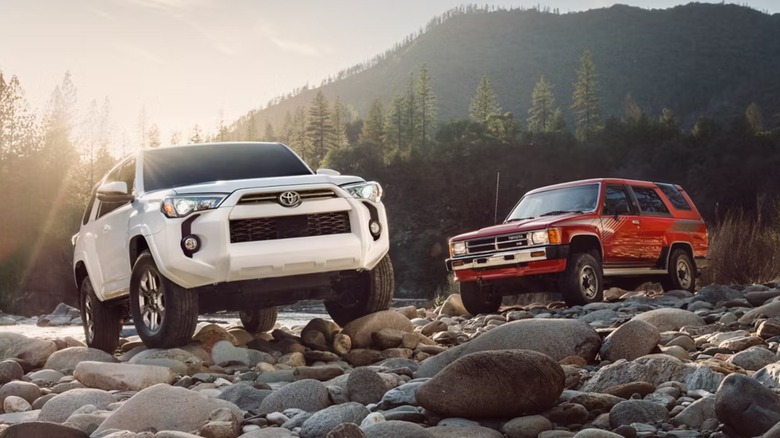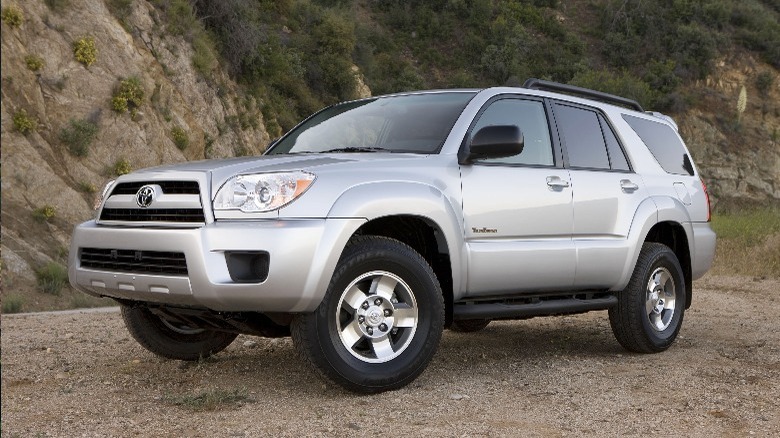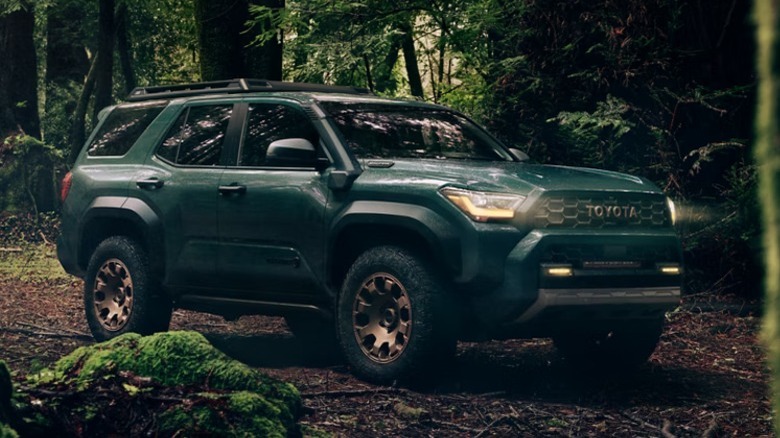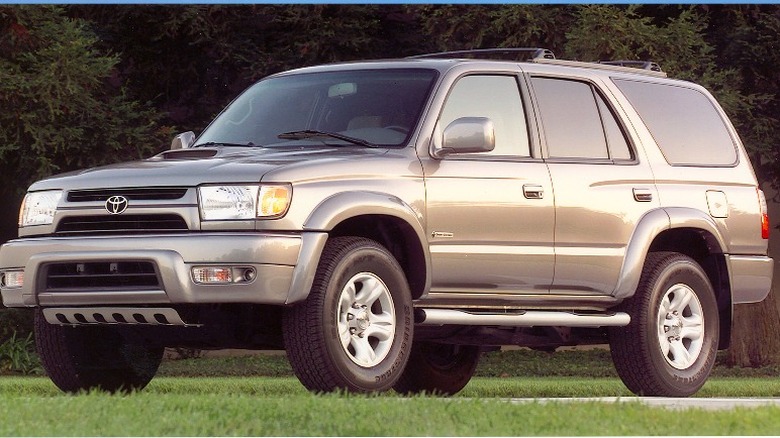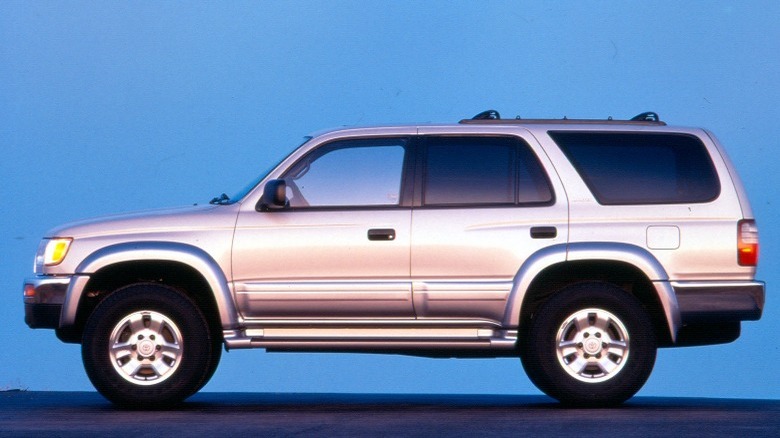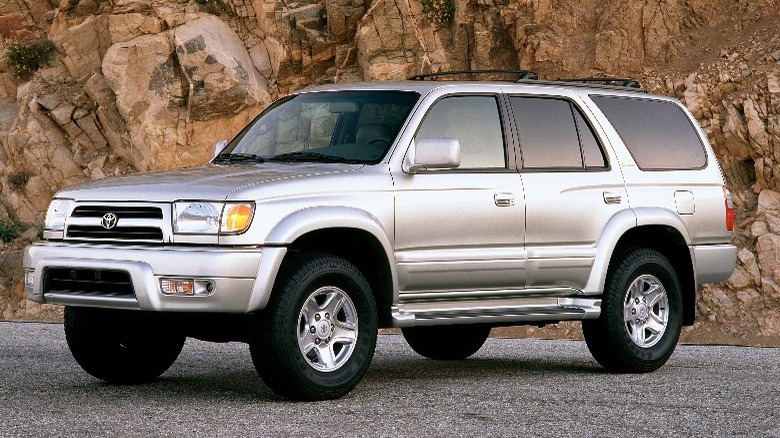5 Of The Best Toyota 4Runner Years For Adventure & Off-Roading
The Toyota 4Runner is an excellent machine. This vehicle was first launched in 1984 and has been an important part of the Toyota lineup ever since. There are a lot of reasons why so many people love this model — it's affordable, gets reasonably good mileage, and benefits from Toyota's sterling reputation for reliability. It's a bit of an unusual one, though.
The 4Runner treads the line between pickup truck and SUV, making it difficult to categorize, which has often led to it frequently being overshadowed by its more solidly truck-like sibling, the Tacoma, or its more SUV like sibling, the RAV4. Many believe that the current generation of 4Runner is in dire need of a redesign, but that doesn't change the fact that 4Runners new and old still have some die-hard fans. It has some unique features like drop-down rear glass in the tailgate that these fans love. There's another reason this truck has managed to stick around for over forty years, though — it's also a pretty capable off-roading machine.
That said, there have been a lot of wildly different iterations of the 4Runnner over the years. 2022 marked the start of the fifth generation of the vehicle, so it goes without saying that some of them are a lot better at adventure and off-roading than others. So whether you're looking to hit the trails for some weekend fun or you're just looking to pick up a truck that can handle life that goes a bit off the grid, it might be worth your while to take a look at some of the best 4Runner years for off-road driving.
2009 4Runner Limited, V8 4x4
If you're looking for an older 4Runner with a big, beefy engine, then it's hard to beat the absolute pinnacle of the fourth generation: The 2009 4Runner Limited, V8 4x4. This absolute beast of a machine was one of the most powerful 4Runners Toyota had ever built in its time, and it held on to that title for a good while. It had a 4.7L V8 engine that could hit 260 horsepower at 5,400 rpm and 306 lb-ft of torque at 3,400 rpm. It also had a 7,000 lb. towing capacity, ABS, Driveline Traction Control, and, as the name implies, came standard with four-wheel drive.
Gear Patrol tested this particular model out just a few years ago and found that it still performs admirably. "Utilitarians will appreciate the 9.1 inches of ground clearance [...] optional locking rear differential, optional Bilstein shocks, and hefty towing capabilities," they said. "In our limited off-road testing [...] the 4Runner remained composed, navigating steep obstacles and potholes the size of a Prius without skipping a beat."
The fourth gen 4Runners are often considered second best when it comes to off-road capabilities among enthusiasts, but the '09 Limited, V8 4x4 definitely deserves to be ranked near the top just by virtue of its raw power.
2025 4Runner Trailhunter
The newest addition to Toyota's line-up definitely deserves a spot on this list. Every generation of 4Runner has had options for off-road capability, but the newest models bring the latest technology to the fore. Now that the 2025 4Runner is finally here, we can finally see that Toyota has learned from its earlier fifth gen mistakes and has invested heavily in improving the SUV's technological capabilities.
There are nine different grades of 4Runner this year, but the Trailhunter is the one most suited to driving off-road. All of them have off-road features like ATRAC traction control and three drivetrains with limited-slip rear differential, and they are all offered in either part or full-time four-wheel drive modes. They're also all powered by the new i-Force engine, which can produce up to 278 horsepower and 317 lb-ft of torque. This would be good on its own, but those who get the hybrid drive models will be able to attain a significantly more impressive 326 horsepower and 456 lb-ft of torque -– a huge step-up, even when compared to the old V8.
The Trailhunter is the only grade that comes with ARB Old Man Emu shocks and an ARB roof rack, though. It also has several exterior low-lighting options that may come in handy when taking it off the beaten path. This makes it a cut above some of the other new models.
2002 Limited Sport Utility 4Runner
There are a lot of nice things about the newer models, but if you're specifically looking at off-roading capabilities, then most enthusiasts agree that the third generation of the 4Runner was when Toyota really hit the nail on the head. Toyota-4Runner.org took a poll from nearly 2,000 contributors asking which generation was the best for off-roading, and the third gen took almost half the votes (more than twice as many votes as the runner-up). There's a good reason for that as well. It had a V6, 3.4L engine that could get 183 horsepower at 4,800 rpm and there were a lot of adventure-friendly features that were introduced in the third generation that were phased out in favor of the more car-like comfort that Toyota prioritized in later generations.
The general rule with most car generations is that the last year tends to be the best, as it is the version of the vehicle that has had most of its kinks ironed out. This isn't always the case, however. The 4Runner first started making its shift to a more road-safe and comfort-oriented vehicle in 2001–2002. Good for driving, but less optimized for recreational four-wheeling. For example, the 2001–2002 models were only available with an automatic transmission, which many off-roading aficionados may not prefer. It did come with a multimode locking center differential instead of a transfer case, but one of the biggest losses was that these years were the only ones in the third-gen that didn't have the option to add the electronic locking differential (or e-locker) which HotCars reports was only available from 1996-2000. "2001-onwards models got a center differential locker, along with Traction Control."
1998 Limited Sport Utility 4Runner
The third-generation 4Runner was first introduced in 1996. There were then three very similar years, ending with the 1998 model. These were the only years in the third generation that the 4Runner came with the smaller, more classic-looking chrome bumpers instead of the larger painted ones. Many collectors prefer this classic design to the more modern appeal found in the painted bumpers on 4Runners of later years. The earliest models had a lot of the features that off-roaders enjoy, but that ended up being phased out in 2001.
As mentioned previously, the 1996–2000 models were the only years in the generation that offered the option to add an electronic locking rear differential -– something that is particularly useful when off-roading in low-traction situations. The '98 model was also sold with the option for a manual transmission, giving drivers significantly more control than the automatic-only models that would be introduced a few years later. Add all this up, and you will see a feature set that naturally lends itself to off-roading. There are a few reasons why the '99 is a bit better, though.
1999 Limited Sport Utility 4Runner
The 1999 Limited Sport Utility 4Runner is the best of the third generation, which in turn makes it a strong contender for the best 4Runner for off-roading of all time. According to MotorTrend, "Limited 4Runners also were fitted with Toyota's Multi-Mode transfer case beginning in 1999 which offered 2HI, 4HI, and 4LO options with the additional option to unlock the center differential in 4HI simulating AWD. The electronic locking rear differential was offered as an option on all trim levels (not standard) from 1996 until 2000 when it was replaced by Toyota's new traction control system, called A-TRAC, in 2001." This means that '99-'00 was the only time period in the third generation where both the multimode AWD and the rear e-locker were both available on the Limited trim.
Having the multimode was nice because you could use a button to engage four-wheel drive, and the transfer case would allow the drive shafts to rotate independently. This helped to avoid binding on high-traction surfaces. Having both this and the e-locker allows drivers to gain traction in several uniquely challenging off-roading scenarios. This makes 4Runners from these two years that had both options among the most desirable ones on the market.
The '99 in particular benefited from some nice quality of like improvements and, though it might not be your first priority, several collectors have also joked that it is the best year because it has the best cupholders. So you can rest assured that it really does have everything.
